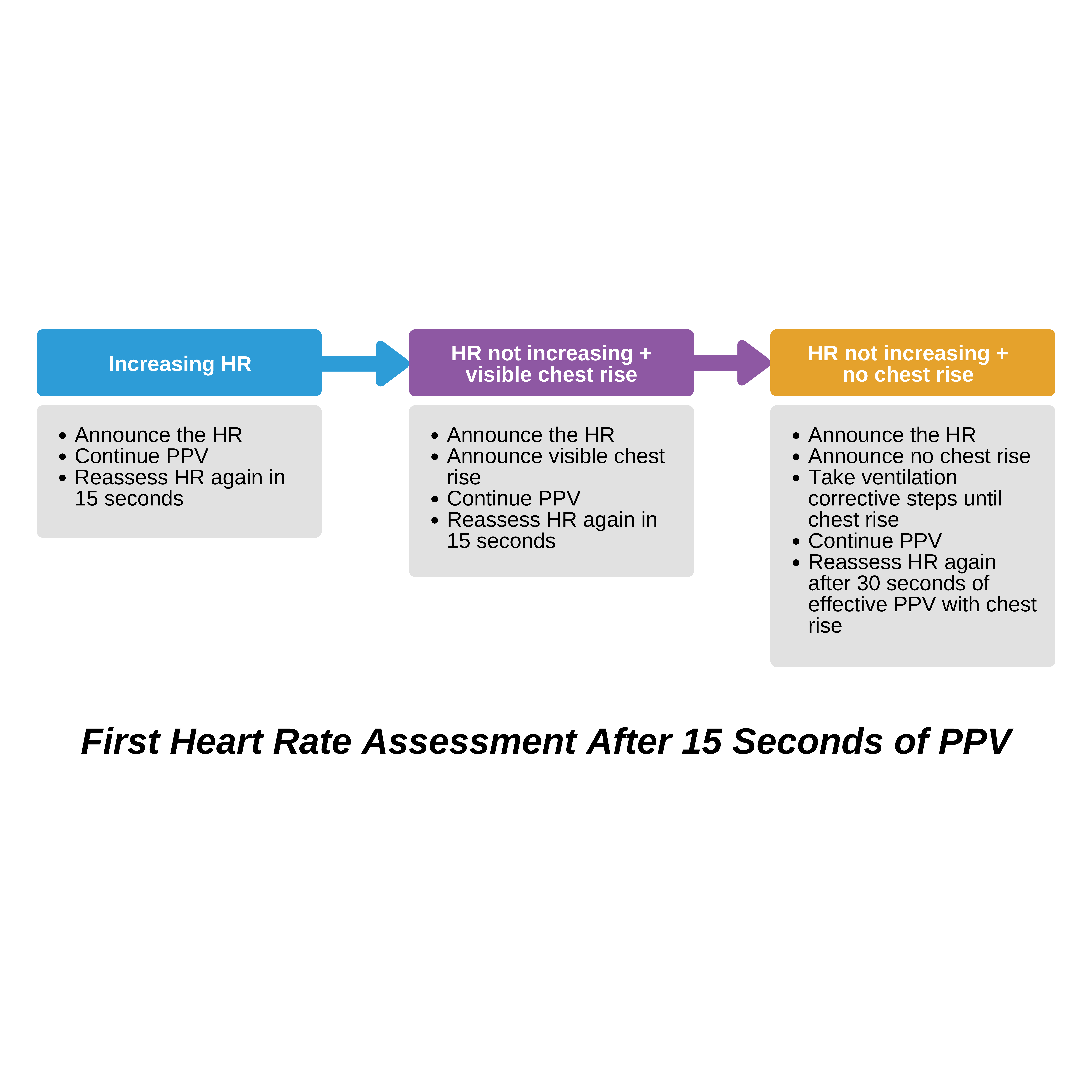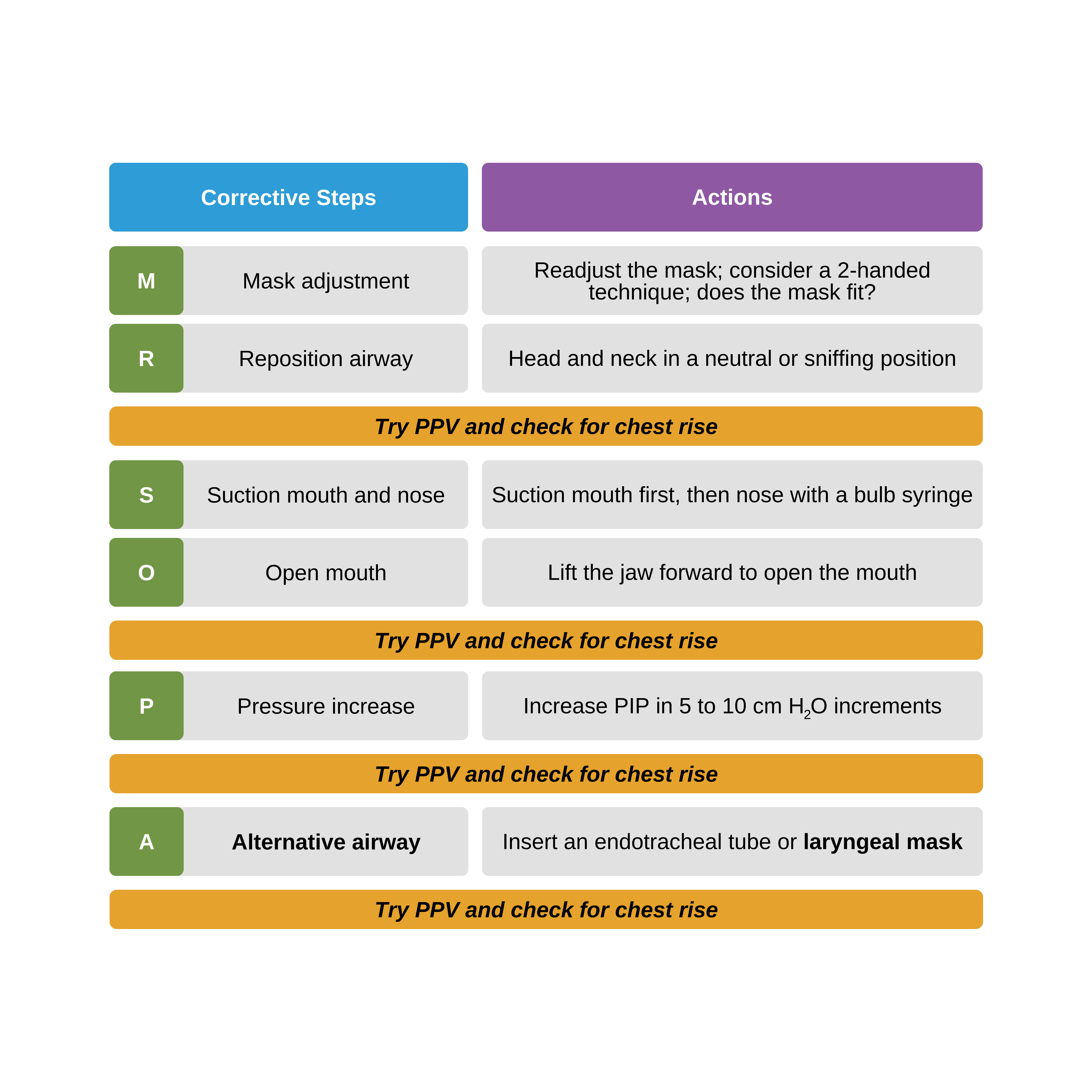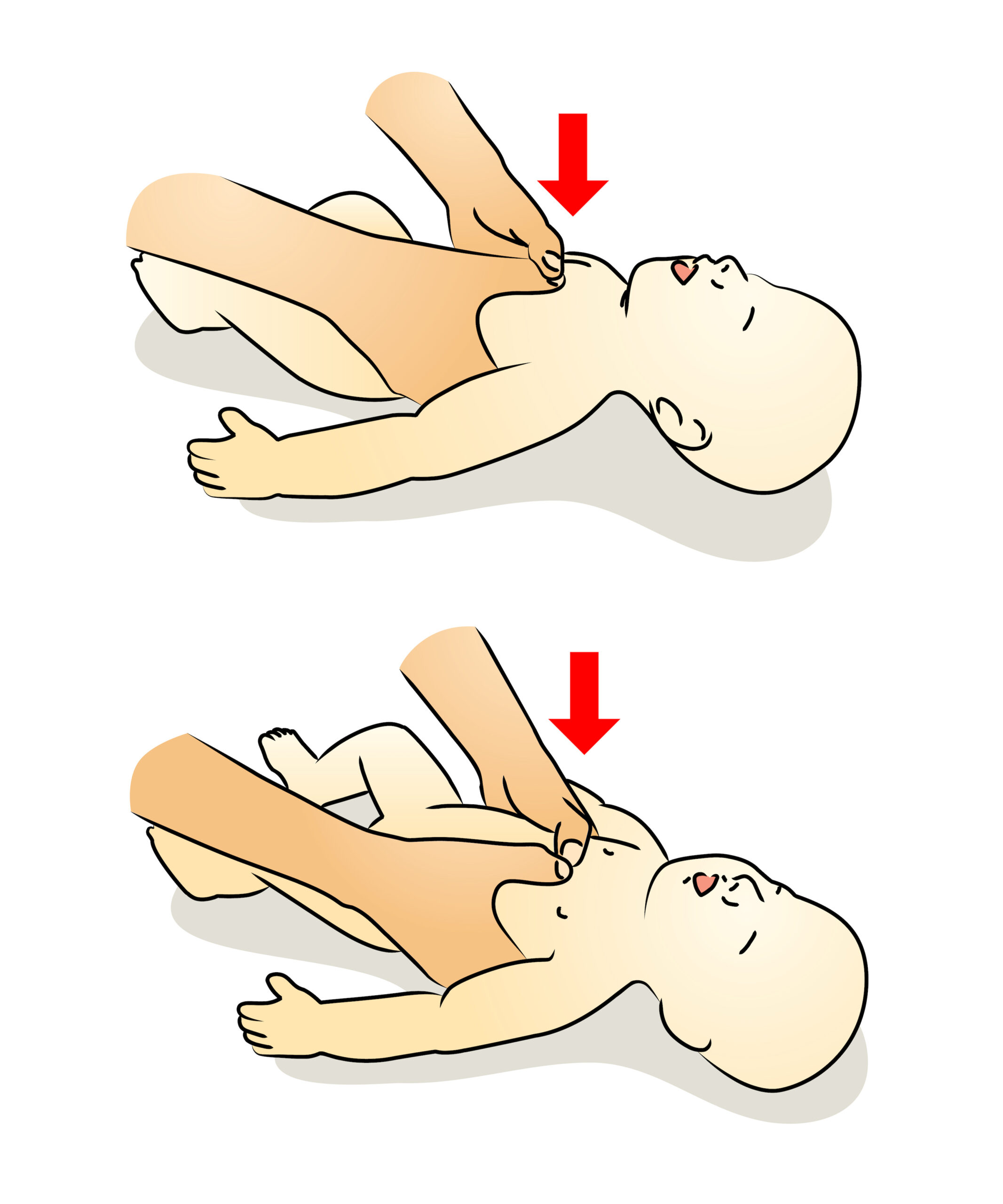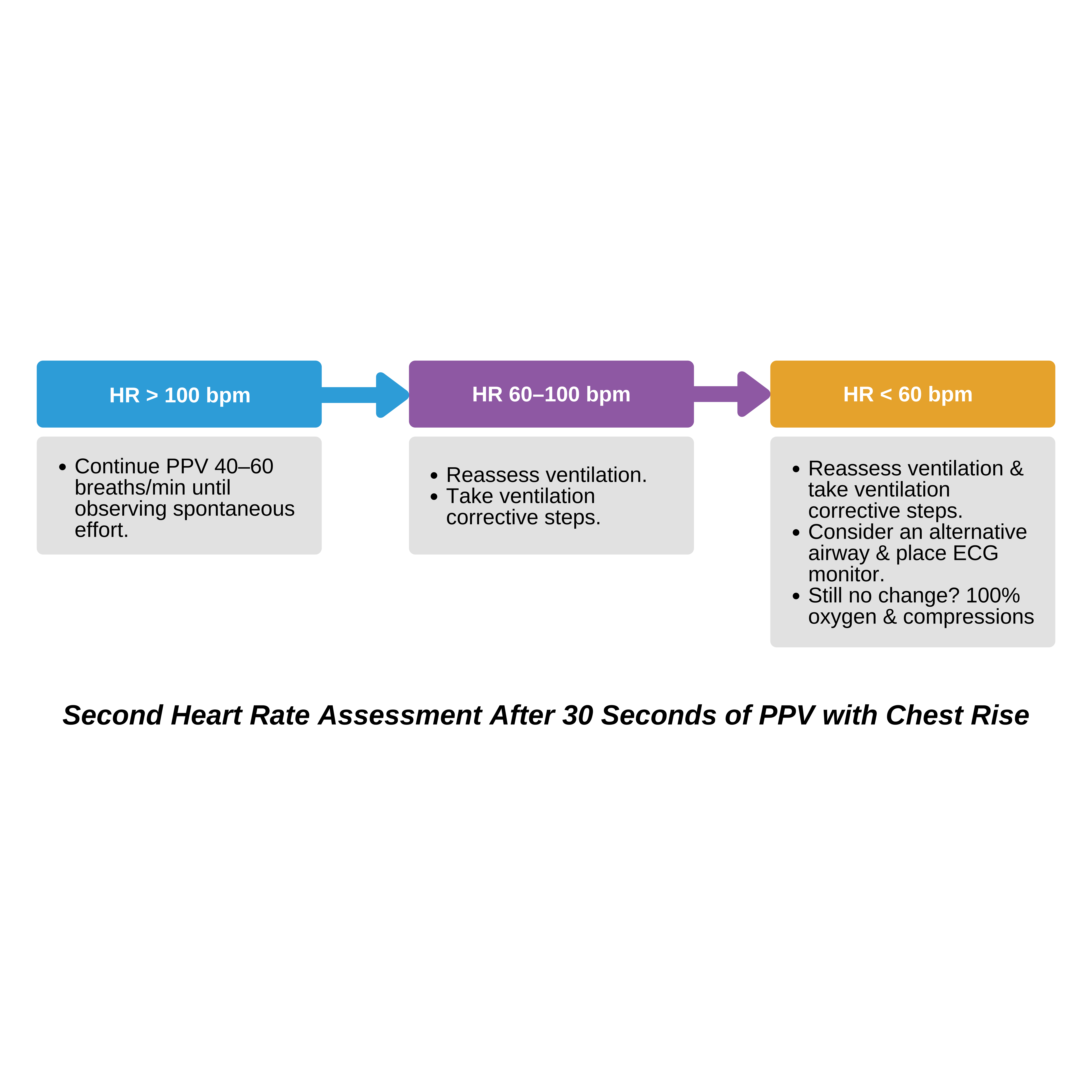Evaluating Positive Pressure Ventilation
Evaluating Positive Pressure Ventilation
Initial Heart Rate Assessment
A rising heart rate is the most significant clinical finding of successful resuscitation. Once PPV is initiated, a team member monitors the pulse oximeter, ECG heart rate monitor, and auscultates for a heartbeat.
The first heart rate assessment occurs after 15 seconds of PPV. The newborn’s heart rate should be increasing if PPV is effective, and the lungs are inflating. The team member should announce that the baby’s heart rate is increasing. PPV continues until another 15 seconds have passed, and the clinician performs a second assessment.
If the heart rate is not increasing at the 15-second point, the team looks for reasons that PPV is not inflating the lungs and implements corrective measures. If the heart rate is not improving, but chest rise is visible, a team member announces that there is chest movement and PPV continues.
The clinician reassesses the baby again after another 15 seconds. If there is no chest rise, the team member announces that the chest is not moving. The team looks for reasons that PPV is not inflating the lungs and implements corrective measures. Once the infant has visible chest movement, PPV continues for 30 seconds before the next heart rate assessment.

Ventilation Corrective Steps
The mnemonic MR. SOPA guides the team’s corrective measures when PPV is ineffective. When visible chest rise is not evident, there may be a leak, an obstruction, or insufficient ventilation pressure. The MR. SOPA mnemonic addresses each of these issues with stepwise interventions. After each intervention, PPV is reattempted.

When performing a mask adjustment, the provider removes the mask from the infant and then reapplies the mask to the face, ensuring that there is a good seal. Signs of a good seal include achieving the desired PIP, maintaining PEEP, and rapid reinflation of the flow-inflating bag.
If a leak is suspected, a little more pressure can be applied to the rim of the mask while gently lifting the infant’s jaw toward the mask. The cheeks and bridge of the nose are the most common areas for a mask leak. If there is still a leak after these interventions, a two-handed / two-person technique should be considered. Also, the provider should reevaluate if the mask is the proper size for the baby’s face.
Repositioning of the newborn’s head simply involves gently manipulating it into a neutral or sniffing position. A rolled towel may be placed just behind the baby’s shoulders. PPV should be resumed, and chest rise assessed after performing these two steps. If there is still no visible chest rise, the team performs the next corrective step, suctioning.
If suctioning fails to result in chest rise during PPV, the baby’s mouth can be opened with a finger. After performing the S and O steps, PPV is reattempted. If the chest is still not moving, the team continues to the next corrective measure.
At this point, if there is no chest rise, the delivered pressure may not be enough to inflate the lungs. Therefore, it is necessary to adjust the settings to increase the pressure. A manometer shows the provider how much pressure is being administered to the patient. The PIP can be increased in 5 to 10 cm H2O increments until chest rise is achieved.
If the team utilizes a T-piece resuscitator, the PIP is adjusted by manipulating the PIP control knob. If the team uses a self-inflating bag, the pop-off valve must be blocked to achieve a PIP higher than 20 cm H2O. Generally, the maximum initial pressure for a term newborn is 40 cm H2O.
Once the clinician reaches the maximum pressure of 40 cm H2O without chest rise, it is necessary to consider an alternative airway (endotracheal tube or laryngeal mask airway). An ECG monitor should be placed at this point in the resuscitation.
Once the ET tube or laryngeal mask is in place, PPV is performed, and the baby is assessed for effective chest rise and breath sounds. Once chest movement is visible, someone should announce that chest rise has been achieved so that the whole team can be informed.
Second Heart Rate Assessment
The second heart rate assessment occurs after 30 seconds of effective PPV (i.e., PPV with chest rise). The corrective steps are repeated as needed if there is still difficulty achieving a chest rise with PPV. The goal is a heart rate of > 100 beats per minute.
Heart Rate > 100 bpm
Once the infant’s heart rate is > 100 bpm, PPV continues at a rate of 40–60 breaths per minute. Heart rate, chest rise, and respiratory effort are continuously evaluated.
The oxygen concentration is titrated as necessary to achieve the target preductal oxygen saturation by observing the pulse oximeter readings. If, after some time, the heart rate is consistently > 100 bpm, the clinician can gradually reduce the pressure and rate of PPV. Once the baby can sustain spontaneous breathing with adequate respiratory effort and oxygen saturation, PPV can be completely discontinued. The baby must continue to be monitored and may still require free-flow oxygen or CPAP.
Heart Rate 60–100 bpm
If the baby is exhibiting improvement, only PPV is necessary. If the baby does not improve, the team assesses the ventilation technique, evaluating chest rise and breath sounds. The team performs the MR. SOPA corrective steps. If an alternative airway is deemed necessary, an ECG monitor should be placed as well.
The team monitors the baby’s heart rate, chest movement, respiratory effort, and SpO2. The oxygen concentration is adjusted to meet the predicted preductal oxygen saturation. The team considers an advanced airway and seeks additional expertise from a neonatologist or intensivist.
Heart Rate < 60 bpm
It is rare when a neonate does not respond to PPV. When the HR is < 60 bpm, the team reassesses the ventilation technique by:
- looking for chest rise
- checking for clear equal bilateral chest sounds
- performing the corrective steps
Oxygen concentration is titrated to the predicted preductal O2 saturation. The team considers inserting an alternative airway and calls the neonatologist for expert consultation.
Key Takeaway
If the infant’s heart rate remains < 60 bpm, the team must begin chest compressions.
If the heart rate remains < 60 bpm and fails to improve, the oxygen concentration is quickly increased to 100%, and the team begins chest compressions.

Infant chest compressions.
Related Video – Understanding Infant Landmarks
Related Video – 2 rescuer CPR for Infants
